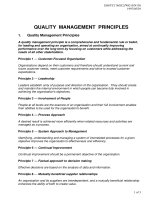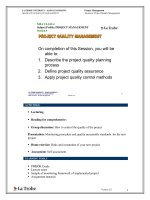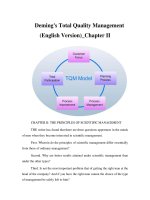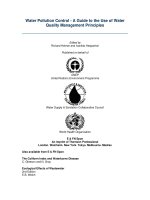QUALITY MANAGEMENT PRINCIPLES
Bạn đang xem bản rút gọn của tài liệu. Xem và tải ngay bản đầy đủ của tài liệu tại đây (48.93 KB, 10 trang )
ISO/TC176/SC2/WG15/N130
1997/05/29
1 of 3
QUALITY MANAGEMENT PRINCIPLES
1. Quality Management Principles
A quality management principle is a comprehensive and fundamental rule or belief,
for leading and operating an organisation, aimed at continually improving
performance over the long term by focusing on customers while addressing the
needs of all other stakeholders.
Principle 1 — Customer-Focused Organisation
Organisations depend on their customers and therefore should understand current and
future customer needs, meet customer requirements and strive to exceed customer
expectations.
Principle 2 — Leadership
Leaders establish unity of purpose and direction of the organisation. They should create
and maintain the internal environment in which people can become fully involved in
achieving the organisation's objectives.
Principle 3 — Involvement of People
People at all levels are the essence of an organisation and their full involvement enables
their abilities to be used for the organisation's benefit.
Principle 4 — Process Approach
A desired result is achieved more efficiently when related resources and activities are
managed as a process.
Principle 5 — System Approach to Management
Identifying, understanding and managing a system of interrelated processes for a given
objective improves the organisation’s effectiveness and efficiency.
Principle 6 — Continual Improvement
Continual improvement should be a permanent objective of the organisation.
Principle 7 — Factual approach to decision making
Effective decisions are based on the analysis of data and information.
Principle 8 — Mutually beneficial supplier relationships
An organisation and its suppliers are interdependent, and a mutually beneficial relationship
enhances the ability of both to create value.
ISO/TC 176/SC 2/WG 15/N131
1997/05/29
1 of 11
Quality Management Principles and Guidelines For
Their Application
1.0 Introduction
This document provides an understanding of the Quality Management Principles that will
facilitate a successful management culture for users of the ISO 9000 Family of standards and
guidelines. The ISO 9000 Family of standards will be based on these Quality Management
Principles.
With growing global competition, quality management is becoming increasingly important to the
leadership and management of all organisations. The Quality Management Principles apply
universally to all user groups. This document focuses on the needs of executive managers. The
Quality Management Principles may be incorporated into new or existing documents to satisfy the
needs of other user groups.
By applying the following eight Quality Management Principles, organisations will produce benefits
for customers, owners, people, suppliers, local communities and society at large.
2.0 Quality Management Principles
A quality management principle is a comprehensive and fundamental rule or belief, for leading
and operating an organisation, aimed at continually improving performance over the long term
by focusing on customers while addressing the needs of all other stakeholders.
ISO/TC 176/SC 2/WG 15/N131
1997/05/29
2 of 11
Principle 1 -
Customer-Focused Organisation
"Organisations depend on their customers and therefore should
understand current and future customer needs, meet customer
requirements and strive to exceed customer expectations".
Applying the principle of customer-focused organisation leads to the following actions:
•
understanding the whole range of customer needs and expectations for products, delivery, price,
dependability, etc.
• ensuring a balanced approach among customers and other stakeholders (owners, people,
suppliers, local communities and society at large) needs and expectations.
• communicating these needs and expectations throughout the organisation,
• measuring customer satisfaction and acting on results, and
• managing customer relationships.
Beneficial applications of this principle include:
• for policy and strategy formulation, making customer needs and the needs of other
stakeholders understood throughout the organisation;
• for goal and target setting, ensuring that relevant goals and targets are directly linked to
customer needs and expectations;
• for operational management, improving the performance of the organisation to meet customer
needs;
• for human resources management, ensuring the people have the knowledge and skills required
to satisfy the organisation's customers.
ISO/TC 176/SC 2/WG 15/N131
1997/05/29
3 of 11
Principle 2 -
Leadership
"Leaders establish unity of purpose and direction of the organisation.
They should create and maintain the internal environment in which people
can become fully involved in achieving the organisation's objectives."
Applying the principle of leadership leads to the following actions:
• being proactive and leading by example,
• understanding and responding to changes in the external environment,
• considering the needs of all stakeholders including customers, owners, people, suppliers, local
communities and society at large,
• establishing a clear vision of the organisation's future,
• establishing shared values and ethical role models at all levels of the organisation,
• building trust and eliminating fear,
• providing people with the required resources and freedom to act with responsibility and
accountability,
• inspiring, encouraging and recognizing people's contributions,
• promoting open and honest communication,
• educating, training and coaching people,
• setting challenging goals and targets, and
• implementing strategy to achieve these goals and targets.
Beneficial applications of this principle include:
• for policy and strategy formulation, establishing and communicating a clear vision of the
organisation's future;
• for goal and target setting, translating the vision of the organisation into measurable goals and
targets;
• for operational management, empowered and involved people achieve the organisation's
objectives;
• for human resource management, having an empowered, motivated, well informed and stable
workforce.
ISO/TC 176/SC 2/WG 15/N131
1997/05/29
4 of 11
Principle 3 -
Involvement of People
"People at all levels are the essence of an organisation
and their full involvement enables their abilities to
be used for the organisation's benefit".
Applying the principle of involvement of people leads to the following actions by the
people:
• accepting ownership and responsibility to solve problems,
• actively seeking opportunities to make improvements,
• actively seeking opportunities to enhance their competencies, knowledge and experience,
• freely sharing knowledge and experience in teams and groups,
• focusing on the creation of value for customers,
• being innovative and creative in furthering the organisations objectives,
• better representing the organisation to customers, local communities and society at large,
• deriving satisfaction from their work, and
• be enthusiastic and proud to be part of the organisation.
Beneficial applications of this principle include:
• for policy and strategy formulation, people effectively contributing to improvement of the
policy and strategies of the organisation;
• for goal and target setting, people sharing ownership of the organisation's goals;
• for operational management, people being involved in appropriate decisions and process
improvements;
• for human resource management, people being more satisfied with their jobs and being
actively involved in their personal growth and development, for the organisation's benefit.









